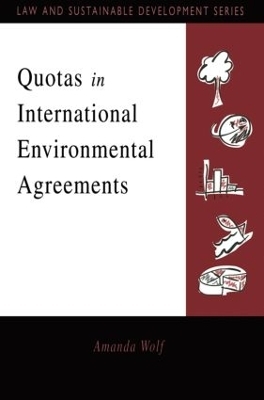
Quotas in International Environmental Agreements
Seiten
1997
Earthscan Ltd (Verlag)
978-1-85383-400-4 (ISBN)
Earthscan Ltd (Verlag)
978-1-85383-400-4 (ISBN)
Quotas have been used in international environmental agreements for at least a century and, in tandem with incentive approaches, should continue to be crucial to realizing a sustainable environment. This text examines quotas both as regulatory tools and as products of negotiation. It reviews the main features of environmental problems.
Quotas have been used in international environmental agreements for at least a century and, in tandem with incentive approaches, should continue to be crucial to realizing a sustainable environment. This text is a critical examination of quotas both as regulatory tools and as products of negotiation. It reviews the main features of environmental problems, the regulatory options and criteria used to judge them, and the various ways of explaining negotiated outcomes. Quotas in the management of fisheries, other resources, freshwater and marine pollution, and air pollution are also described. Selected examples are considered in detail to provide an understanding of how quotas were developed in scientific, political, economic and social context. An assessment of the key features of quotas in practice leads to the identification of an emerging approach, the negotiation of constrained local quotas. The approach is a practical way to balance efficiency and fairness in complex negotiations, without sacrificing environmental effectiveness.
Quotas have been used in international environmental agreements for at least a century and, in tandem with incentive approaches, should continue to be crucial to realizing a sustainable environment. This text is a critical examination of quotas both as regulatory tools and as products of negotiation. It reviews the main features of environmental problems, the regulatory options and criteria used to judge them, and the various ways of explaining negotiated outcomes. Quotas in the management of fisheries, other resources, freshwater and marine pollution, and air pollution are also described. Selected examples are considered in detail to provide an understanding of how quotas were developed in scientific, political, economic and social context. An assessment of the key features of quotas in practice leads to the identification of an emerging approach, the negotiation of constrained local quotas. The approach is a practical way to balance efficiency and fairness in complex negotiations, without sacrificing environmental effectiveness.
Amanda Wolf is a lecturer in Public Policy at Victoria University of Wellington, New Zealand.
Part I: International Environmental Problems and the Negotiated Choice of Policy Mechanisms - Introduction * Environmental Problems and the Negotiation Context * Policy Mechanisms for Addressing International Environmental Problems * Choosing a Policy Mechanism * Part II: Quotas in Conservation and Pollution Agreements - Introduction * Fisheries * Conserving of Living and Non-Living Resources * Freshwater and Marine Pollution * Air Pollution Part III: Assessment and Prospects - Introduction * Negotiating Quotas: an Assessment * Constrained Local Quotas * Prospects * Endnotes * References * Index
| Reihe/Serie | Earthscan Law and Sustainable Development |
|---|---|
| Verlagsort | London |
| Sprache | englisch |
| Maße | 156 x 234 mm |
| Gewicht | 340 g |
| Themenwelt | Recht / Steuern ► EU / Internationales Recht |
| Sozialwissenschaften ► Politik / Verwaltung ► Europäische / Internationale Politik | |
| Sozialwissenschaften ► Politik / Verwaltung ► Staat / Verwaltung | |
| Wirtschaft ► Volkswirtschaftslehre | |
| ISBN-10 | 1-85383-400-9 / 1853834009 |
| ISBN-13 | 978-1-85383-400-4 / 9781853834004 |
| Zustand | Neuware |
| Haben Sie eine Frage zum Produkt? |
Mehr entdecken
aus dem Bereich
aus dem Bereich
Studienbuch
Buch | Hardcover (2023)
De Gruyter Oldenbourg (Verlag)
CHF 62,90
erfolgreiche Interessenvertretung durch Prozesskompetenz im komplexen …
Buch | Hardcover (2023)
Wiley-VCH (Verlag)
CHF 58,75


